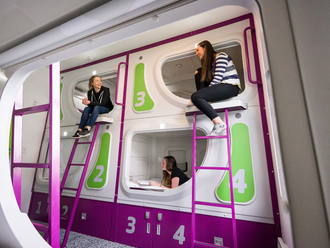
India’s largest bank, State Bank of India, faces a unique challenge — it receives 2,000-3,000 applications daily for every job vacancy it wants to fill. These forms pile up rapidly, and the bank regularly deals with the daunting task of sifting through nearly half a million applications, looking for the best of the lot.
In early 2017, the bank approached Zing, a start-up that wants to modernise recruitment and help organisations win the talent acquisition war. “We used artificial intelligence (AI), machine learning (ML), intelligent chatbots and advanced analytics to automate resume parsing and routine HR query processing,” says Prasad Rajappan, CEO and Founder, Zing.
“This not only enabled a streamlined automated recruitment process with no scope for biases, delays and inaccurate fitments but also led to 92 per cent saving of time in shortlisting, 70 per cent improvement in hiring efficiency and 66 per cent saving in costs.”
Similarly, EduGorilla, which claims to be a one-stop education community, has used an amalgamation of AI, ML and neuro-linguistic programming (NLP) to profile more than 600,000 schools and 70,000 plus coaching centres.
“Indian ed-tech start-ups are increasingly leveraging AI and ML, which will go a long way in bridging gaps in the Indian education system,” says Rohit Manglik, CEO, EduGorilla.
He offers the example of teachers, in general, failing to correctly identify unique learning needs of individual students. “AI can help in such instances by preparing customised teaching methodologies for each student. Similarly, the ML algorithms will help teachers in identifying gaps in their pedagogy and teaching method.”
Elsewhere, Healthians, a health tech start-up, is using AI-powered tools to analyse diagnostic tests and deduce probable risk factors, predict a patient’s health trends, and recommend lifestyle changes. Deepak Sahni, Founder CEO, Healthians, explains that AI/ML can play a huge role in early detection, affordable innovations for cure, and easy access to quality health services, even in the innermost pockets of India.
Meanwhile, the crowdfunding platform, ImpactGuru, has deployed AI and ML for fraud detection and for its Story Builder tool that helps campaigners create compelling narratives with just a few clicks.
“About 95 per cent of the medical campaigns have used the Story Builder tool, raising more than Rs11.8 crores (Dh6.2 million). And the fraud detection mechanism uses pattern analysis to highlight, in real time, any possibility of fraud transactions. This helps us reduce the chargebacks to less than 0.2 per cent of all successful transactions,” says Piyush Jain, CEO and Co-founder, ImpactGuru. He adds that as more sectors adopt technology to scale up, they
will get access to massive amounts of digital data, which in turn will be the base for AI and ML innovations.
Current challenges
Manglik believes AI and ML are still at a nascent stage in India. “AI-data ecosystem consisting of general artificial intelligence, narrow artificial intelligence, machine learning, and deep learning, seems to be missing from the Indian landscape.
The fields are necessary to have a full-fledged journey of AI and other such technologies,” he says, noting that in 2016, India produced a mere 600 research papers on AI, while only one Indian company, Tata Consultancy Services (TCS), figures on the list of top 10 researchers in this field.
He also believes there is an acute deficiency in skilled expertise and points to a report by Kelly OCG India that estimates a 60 per cent jump in demand for AI and ML professionals in 2018.
Sahni agrees there is a huge mismatch between demand and supply for AI/ML talent. “Due to this shortage, the high cost of skilled resource becomes a big challenge for Indian start-ups,” he says, while also observing that IP rights implementation in India is at a very primitive stage and special attention must be given to it as Indian start-ups surge ahead with innovations in AI and ML.
Rajappan notes that Indian AI start-ups have witnessed a growth in VC funding, going from $15 million (Dh55 million)in 2015 to $67 million in 2017. But according to venture capital analytics firm Tracxn, 95 AI start-ups were founded in 2016 and only 42 in 2017.
He attributes the dip to challenges such as dealing with legacy systems. Other limitations include lack of clean, structured and statistically representative big data, and a dearth of candidates with the skills to analyse data or find the right problem to solve.
The road ahead
While delivering his budget speech earlier this year, India’s Finance Minister,
Arun Jaitley, emphasised that the government think tank, NITI Aayog, will spearhead a national programme on AI. Sahni believes that NITI Aayog’s goal of applying AI to different sectors and increasing the country’s year-on-year (YoY) growth rate by 1.3 per cent will address many pain points across industries.
However, he feels the Rs2 billion allocated in the budget for AI research and development is a marginal amount in comparison to the scale of problems AI start-ups want to solve. “We are sure more budget will be allocated to this initiative. Public-private partnership opportunities can also play a huge role in funding and development.” .
Manglik too is appreciative of NITI Aayog’s efforts, especially the #AIforAll campaign and the collaboration with IBM to come up with a prediction model for crop production, while using AI to give real-time advice to farmers.
“Besides, the 3Nethra equipment, which Niti Aayog is working on along with Microsoft and Forus, is going to be a game changer and will come handy to identify common eye problems. There will also be major development in the field of cancer treatment with the introduction of Imaging Biobank.”
Last month, the UAE and India signed an agreement to spur discussion and explore options for both countries to grow their artificial intelligence economies. The UAE-India collaboration will seek to evaluate the dynamic nature of innovation and technology by convening a UAE-India AI Working Committee between the UAE Ministry for Artificial Intelligence, Invest India and Startup India.
Moreover, as policymakers and government officials get involved in the AI ecosystem, Rajappan predicts it will bolster AI research, while also boosting the confidence of start-ups and investors. “We see a boom in the number of organisations embracing tech innovations such as AI, ML, IoT, analytics, as it becomes discernible how they speed up core business functions.”







